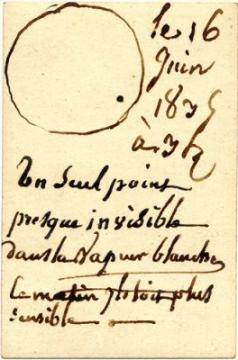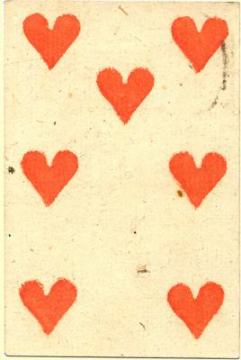****************
# 22
Notes on a sunspot
When writing-paper was not so common and rather expensive,
single playing cards, left over from incomplete packs, were ideal for making
notes. Scientists too have used playing cards to record their discoveries and
ideas. I have never been to university, except to deliver cakes when I was working in a bakery at the age of 17. So it must be my lack of education that it
has taken me years to understand the real meaning of this secondary used card.
 |
The text is very clear:
"On 16 June 1835 at 3:00 h, a single spot, almost invisible in the white mist.
It was more visible in the morning."
Playing card maker unknown,
France.
Gejus van Diggele Collection.
|

|
|
Still, for years I have thought that it was a note made
by a drunkard who saw a fly drowning in his glass of beer. Until at one of my talks somebody suggested that it might have
to do with a sunspot. |
Searching the internet I found a site by Dutch astronomer Steven
M. van Roode and I e-mailed him a picture of the card with my question. His
answer came very swift. No doubt, he stated, this record has to do with a
sunspot. Steven contacted his fellow astronomers in Utrecht and Great Britain to
find out more. The date is somewhat mysterious because it does not match with
the known schedule of sunspots, but the card is certainly a unique record of a
sunspot, one of the oldest written in French. The anonymous observer possessed
specialized equipment, because sunspots cannot be observed with the naked eye.
This notation on a playing card might mean that he was outside at the time and
had no other paper at hand.
Heinrich Schwabe (1789-1875), the German discoverer of the
11-year cycle of the sunspots, took notes on them from 1825 to 1867. These are
now kept in the library of the Royal Astronomical Society in London, England.
The oldest record of sunspots was written by Thomas Harriot, an Englishman, and
was dated 8 December 1610.
Gejus
****************

